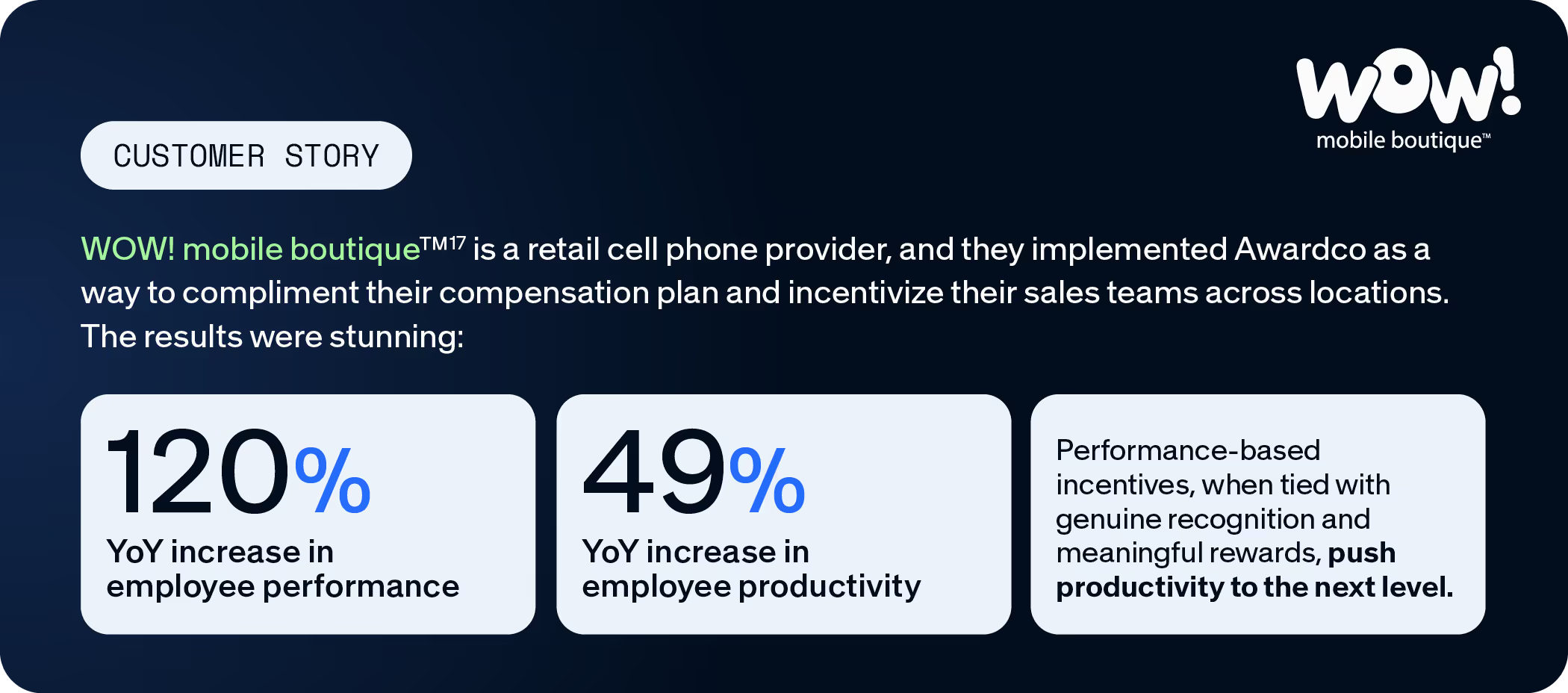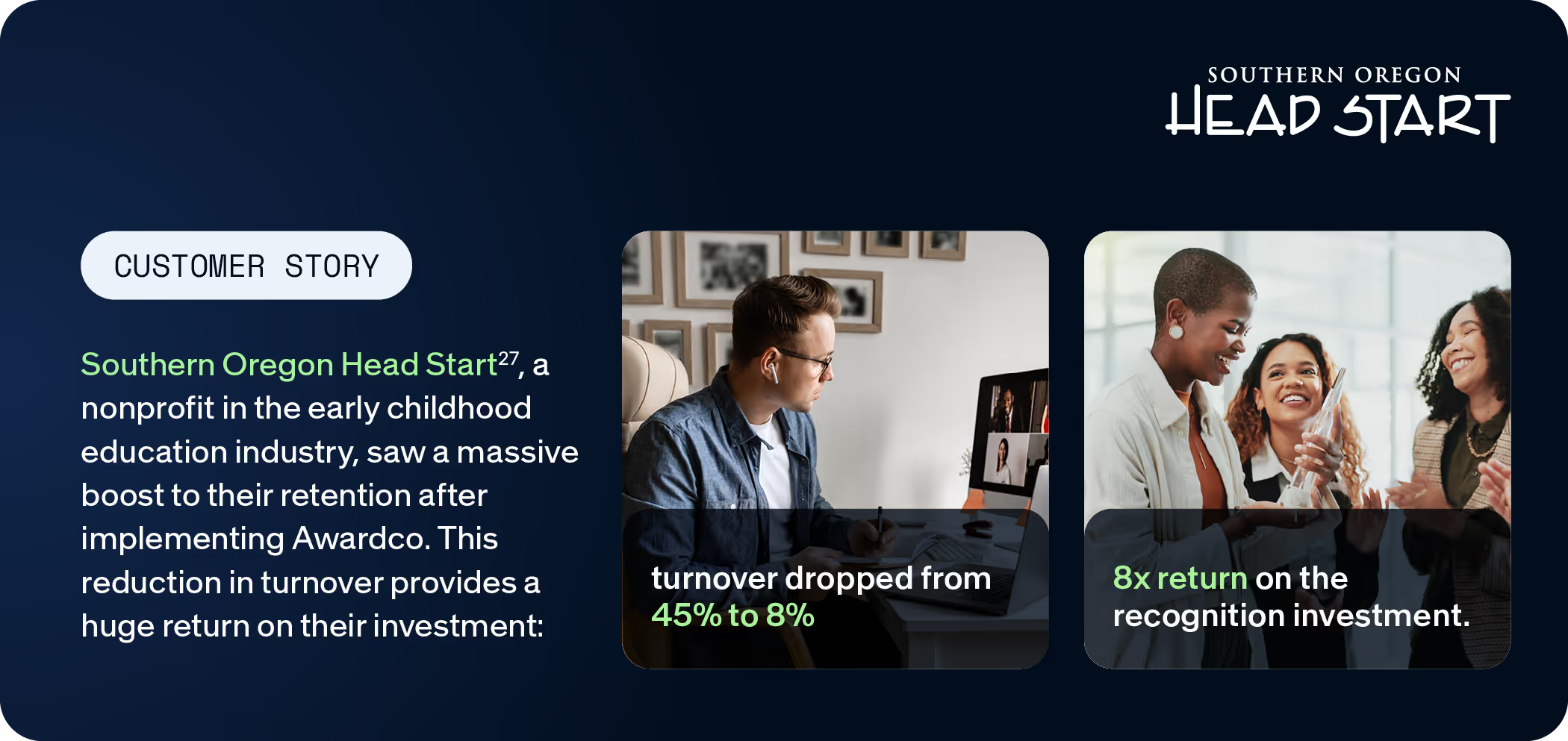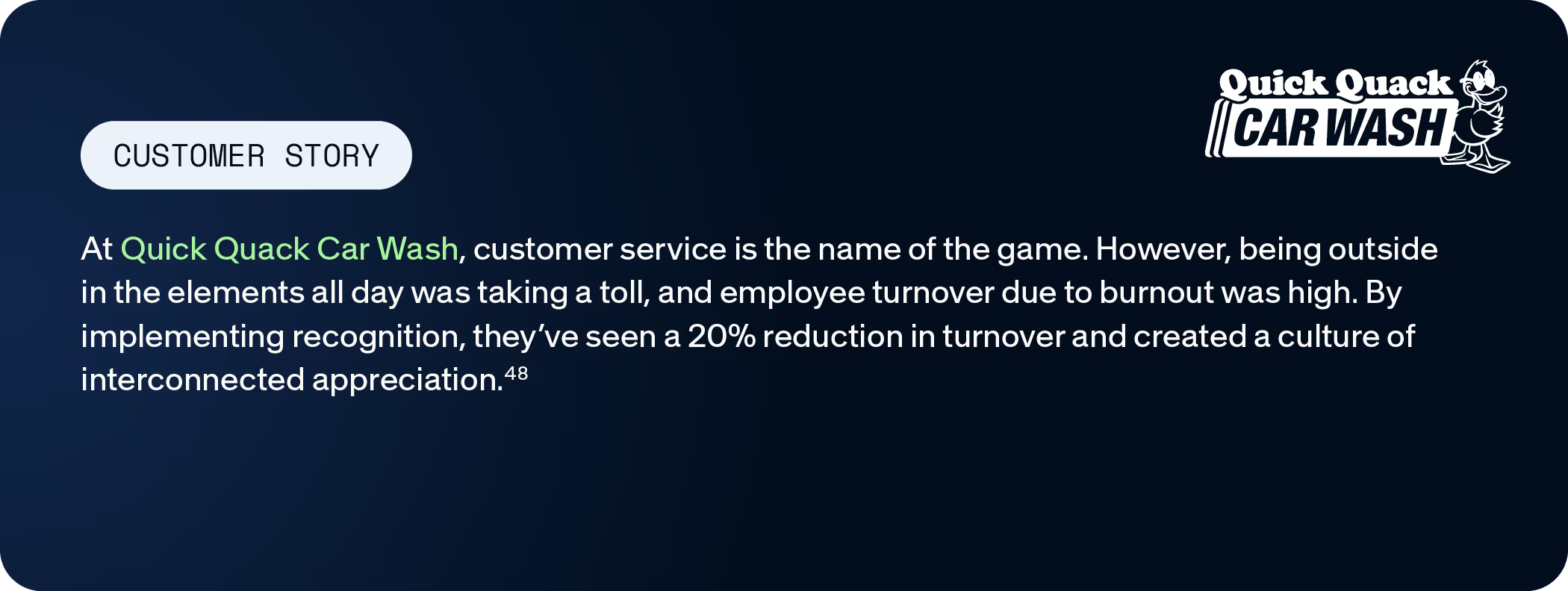Thanks for your message!
We will reach back to you as soon as possible.
The true impact of employee recognition
The work environment demands time and energy day after day, and employees are desperate to feel like their efforts are seen and appreciated. And considering organizations are constantly at war to attract and retain the best talent, this recognition is a proven strategy to build a culture employees love to be a part of.
However, even understanding the impact of appreciation and how it solves many of the modern workplace challenges we all face, business leaders still believe that employee recognition is a frivolous expense—something that’s nice to have but ultimately unnecessary in the face of bottom-line results.
It’s time to put that erroneous idea to rest, permanently.
The truth is, employee recognition impacts nearly every measure of business success, including:
- Engagement
- Productivity and performance
- Retention
- Company culture
- Burnout and motivation
This report analyzes recent industry research to highlight the ROI of employee recognition, and provides best practices for how to improve recognition in any organization to build culture, incentivize performance, and power engagement strategies that impact the bottom line.
See a breakdown of how recognition influences these Key Performance Indicators and get the quantifiable data you need to present the case of recognition to stakeholders effectively.
How employee recognition improves engagement
Employee engagement is how invested a person is in their day-to-day work. Engagement bleeds into every aspect of an employee’s experience—engaged employees are more productive, more likely to stay, more profitable for the organization, and better culture builders.
Current employee engagement landscape
- Engagement dropped to 21% in 2024, an all-time low
- Disengagement cost the world economy $438 billion in lost productivity
How does employee recognition improve employee engagement?
- Incentives used to recognize and reward employees’ contributions raise engagement by 89%
- When leaders are great at recognizing, employees are 40% more engaged
- Genuine feedback makes employees 5X more likely to be engaged
- Employees who strongly agree that recognition is important to their organization’s culture are 3.7x more likely to be engaged
When employees feel like their work is noticed and appreciated, they care more about it and put more effort in. It’s as simple as that.
How does increased engagement improve your bottom line?
Companies with high levels of engagement are 21% more profitable. So if a company with an annual revenue of $1,000,000 boosts their engagement levels, they can generate an extra $210,000.

How employee recognition improves productivity and performance
Productivity measures the effectiveness and efficiency of work done. Generally, it’s measured in the amount of value created for each hour of work.
Current productivity and performance landscape
- Lost productivity cost the world economy $438 billion in 2024
- A recent survey showed employees feel productive only three hours a day
- Over 50% of workers say their productivity is down
- 80% of U.S. workers report feeling productivity anxiety
How does employee recognition improve productivity?
- Recognition increases productivity by 14%
- Incentives and rewards increase productivity by 22%
- Symbolic rewards significantly increase performance
- 92% of employees are likely to repeat a specific action after being recognized for it
Research shows that employees who are regularly recognized are more productive, positive, motivated, and loyal.
How does this increased productivity improve your bottom line?
According to research, an average employee generates 3x their salary in revenue for their company. For example, an employee making $60,000 will generate $180,000 in revenue for their company. By increasing productivity by 14% employees will perform 14% more work without increasing costs, leading to 14% greater revenue generation.
In the above example, that means that employee will generate $25,200 extra, totalling $205,200 instead of $180,000. A company with 100 employees and an average salary of $60,000 can expect a boost of $2,520,000 from that 14% increase in productivity.

How employee recognition improves retention
Turnover is one of the most costly problems to have. Replacing a single employee has a cost ranging from one half to two times their salary—not to mention the unspoken costs, such as disengagement, lost knowledge, and skill gaps. Here’s what to know about how employee recognition cuts turnover.
Current employee turnover landscape
- 40% average turnover rate for all industries in 2024
- 51% of employees are watching for or actively looking for new jobs (a 10-year high)
- 73% of Gen Z and 70% of Millennials are looking for a job change
How employee recognition improves retention
- Recognition lowers voluntary turnover by 31%
- Employees who are recognized are 45% less likely to quit
- Recognition is a top driver of retention
- Feeling cared for is more important than compensation for retention
- #1 reason people quit is not feeling valued
How improved retention affects your bottom line
If a company with 500 employees and an average salary of $60,000 has a 20% turnover rate, they’re spending anywhere from $3,000,000 to $12,000,000 on turnover-related expenses. By lowering turnover by 30%, which means their turnover rate is 14% instead of 20%, the company will save anywhere from $900,000 to $3,600,000 annually!

How employee recognition improves company culture
Company culture refers to the values, attitudes, and practices that characterize how the company—and more important, its people—act and interact. A strong organizational culture can lead to a 50-point increase in employee engagement and an 85% increase in net profit.
Unfortunately, the average employee doesn’t care much about their company’s culture.
Current company culture landscape
- Only 20% of employees feel connected to their company’s culture
- Toxic culture has caused 19% of employees to leave their positions
- Culture is 10x more important to employees than pay
- 80% of employees consider a company’s culture before applying
How employee recognition improves company culture
- Recognition makes employees 5x more likely to feel connected to company culture
- Employees are 3x more loyal to an organization that prioritizes a culture of recognition
- 87% of employees feel a high level of inclusion when there’s a strong culture of recognition
- When recognition is done well, employees are 4x more likely to recommend their organizations to friends or family
How improved company culture helps your bottom line
Research shows that companies with strong cultures have a 4x increase in revenue growth. So a company with a lackluster culture that makes $1,000,000 in a year could make $4,000,000 by investing in their culture.

How employee recognition improves burnout and motivation
Burnout is when employees feel overworked or over-stressed for too long without help, leading to feeling exhausted, empty, and uncaring. Because burnout impacts productivity, mental capacity, emotional resilience, and morale, it leads to reduced workplace efficacy and disengagement.
Research shows that burnout costs between $4,000 and $21,000 per employee through lost productivity and turnover, or $5,000,000 annually for the average 1,000-person company.
Current burnout and motivation landscape
- 86% of employees have experienced moderate, high, or extreme levels of stress in the past year
- 83% of those respondents agree stress comes primarily from work
- 82% of the workforce is at risk of burnout
- Only 15% of global employees feel motivated at work
How employee recognition improves burnout and stress
- Recognition lowers the odds of burnout by 48%
- Workers who feel a strong sense of belonging are 2.5x less likely to feel burned out
- 49% of employees say recognition motivates them the most
- 78% of employees would be more motivated if they were recognized more
How improved mental wellness improves your bottom line
If burnout costs between $4,000 and $21,000 per employee each year, the benefit is clear: A company with 100 employees can save $40,000 to $210,000 every year in boosted productivity and engagement by lowering stress and burnout.

Effective recognition strategies
The truth is clear: employee recognition improves every single aspect of business success, from productivity and engagement to company culture and motivation. However, token recognition efforts or lackluster rewards will not unlock these benefits. In fact, ineffective recognition and rewards will waste time and money, all while making employees less satisfied and unhappy with the workplace.
Avoid disappointing recognition with these two tiers of basic and sophisticated strategies.
Tier 1: A healthy foundation of recognition
Enhance recognitions themselves
Inauthentic recognition—when it’s self-serving, empty, insincere, or indirect—will backfire. Only 8% of employees who receive what they see as insincere recognition can agree that they are treated with respect at work.
Make sure every recognition the company, leaders, and managers give out is authentic, respectful, and meaningful. To do so, make sure recognition:
- Is timely and specific. Recognition needs to happen soon after the action that’s being recognized, and it needs to specify what and why the person is being recognized.
- Is personal and impactful. What about the employee is being recognized? How can you personalize your message to speak to the employee on an individual level?
- Affirms employees’ value. Recognition is all about showing employees that they’re valued. Recognition should frequently affirm and reaffirm this.
- Clarifies performance. Good recognition fits nicely into the feedback loop by expressing to employees what they do well and showing them gratitude for it.
Utilize monetary and non-monetary recognition
Recognition does not have to have a monetary reward to be effective. It’s important for certain programs and awards, but programs like peer-to-peer recognition can simply be a way for people to express gratitude for small behaviors.
This small-scale recognition is vital to helping people feel valued and seen, and it’s also completely free for the company—the key is to simply encourage and empower it.
Train managers on how to recognize
Data reveals that the most meaningful recognition comes from an employee’s manager. Managers work closely with employees and are in the perfect position to offer frequent recognition.
But effective recognition is a learned skill, so organizations shouldn’t expect managers to know how to show appreciation without any help.
Offer regular manager training to teach them why, how, and when to recognize their direct reports. Give them resources, send out frequent reminders, and make sure company leadership is exemplifying the behavior managers should emulate.
Tier 2: Take recognition to the next level
Invest in official recognition channels
Recognition is effective when it’s frequent and far-reaching. But haphazard, manual, and piece-meal recognition programs don’t get the job done because people don’t participate, people get missed, or recognitions are inauthentic.
A company-wide recognition solution that empowers everyone to both recognize and be recognized is crucial to the success of any recognition initiative.
By investing in a recognition platform, companies can:
- Empower managers and peers to recognize their colleagues whenever they see good work or positive behaviors
- Offer a wide range of items that will take the guesswork and hassle out of rewards and gifts
- Automate reporting, reward fulfillment, and reminders to take the work off of HR’s plate
- Reach all employees, whether they work remotely, in an office, at retail locations, on the manufacturing floor, or anywhere in between
Build customized recognition programs
Custom programs are perfect for designing recognition that fits your culture, your people, your budget, and your areas of concern. Awardco allows near-limitless customization options, and here are some examples:
- Company spirit week, with activities, games, contests, and drawings
- Quarterly awards based on employee nominations
- Incentives that reward any positive behaviors, from hitting work goals to donating blood
- Holiday activities, such as Easter egg hunts, costume contests, or Earth day service work
- Wellness-centric programs
- Onboarding programs
Survey employees to find where they feel unsupported and build a recognition program to fill that gap.
The real Return on Recognition™
Employee recognition impacts each aspect of business, by increasing engagement, productivity, retention, and motivation. And the numbers show that these improvements save you money—not just spare change, but potentially millions of dollars.
It’s time to change the way we work. By investing in effective employee rewards and recognition, you can create a workplace where employees feel valued and seen, and where work isn’t just a paycheck anymore. It’s a place where employees put in their best efforts because they know those efforts are seen.
To see how you can implement recognition to fit your own organization’s needs, reach out to Awardco.




